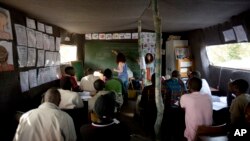The floor is sandy like the nearby dunes, the canvas roof is held up by tree branches covered in flowered cloth and the students seated at small desks are listening with soldierly attention.
"'Light' is 'lumiere,'" said the teacher, giving a French lesson in English to migrants from far corners of the globe, who have converged on a vast camp in the English Channel port city of Calais. "A lamp gives you light.''
The single-room schoolhouse on one edge of the camp known as the "jungle'' might seem like a mirage — but the four to six classes held there every day are packed with students.
The Chemin des Dunes School opened its small door — found in a dustbin — on July 11, the brainchild of Zimako Jones, a Nigerian living in the camp, where an estimated 3,000 migrants have staked out dwellings of sticks and tarp. They are among waves of migrants fleeing violence and poverty and arriving on Europe's shores, crossing internal European borders and straining asylum systems.
Building bridges
"It helps build bridges between the different nationalities,'' Virginie Tiberghien, one of about 20 volunteer teachers, said of the school. "It really helps maintain a sense of humanity even if their daily lives are very difficult.''
Most of the migrants in Calais hope to sneak away through the Channel Tunnel into Britain, believed to offer better prospects for prosperity. With help from the school, which offers a haven from the cruelty of daily life, some are trying to learn enough French to end their travels and apply for asylum in France instead.
The school offers French, English, painting and Tai Chi — or whatever else the teachers, who come from all walks of life, might propose.
But the graffiti on the outside canvas wall of the schoolhouse, perhaps best reflects what is at stake: "Never give up hope,'' says one. "Hey everybody. We are in school,'' says another. The word "ciel,'' French for "sky,'' and a picture of a bird decorate one wall.
Zimako, as he asks to be known, conceived the school and built it with the help of five Sudanese, mostly out of an urge to improve the lives of people in the camp.
"I thought of doing this to help the people of the jungle, to unite them,'' he said. "It's a school without religion, without color. We are all together, people.''
But Zimako also wanted to help himself. He arrived in southern France as a migrant in 2013 and moved in April to Calais, where he has launched an asylum bid. Fluent in French and English, he was inundated with requests from needy migrants. "So many people were coming to me'' for translation help, he said. "I was tired.''
Today, a big chalkboard covers the front wall of the classroom, and pictures of objects from animals to airplanes are posted on walls with their French names. The classroom can squeeze in up to 35 students, who are mainly adults of varying ages.
Giving some dignity
Tiberghien is a speech therapist teaching a French class. Chris Jaumotte, a Belgian graphic artist living in the area, teaches French and art.
"We give them a bit of dignity. I think their dignity is being trampled here ... in this plastic city,'' Jaumotte said, referring to the tarp hovels where those in the jungle take shelter. She gives the students an A for their concentrated effort.
"This is a jungle,'' said 26-year-old Ahmed Riaz of Pakistan, who hopes the school will help him find his way out of the camp. He ended up sitting in the schoolhouse literally by accident — after breaking a leg when he "tried the tracks'' to catch a ride to Britain. Riaz, who is seeking political asylum in France, has attended French class at the school since it opened.
Humanitarian associations have helped contribute supplies such as notebooks and pens. Jaumotte bought the paints, brushes and small pots for each desk in her art class.
At one desk, a young African had tellingly painted a boat at sea, full of people, much like the boatloads of migrants that make the perilous passage across the Mediterranean, as many in the camp have done. The title in red: "Dangrous Days.''
Zimako is humble about his accomplishment. And he keeps thinking big: He wants to build a second, larger school.
"It's ideas at work,'' he said. "It's not me.''







